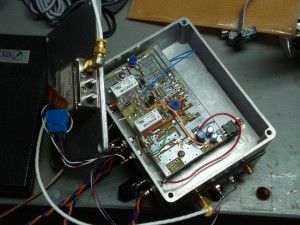
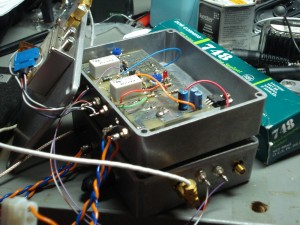
Isn’t it precious?!
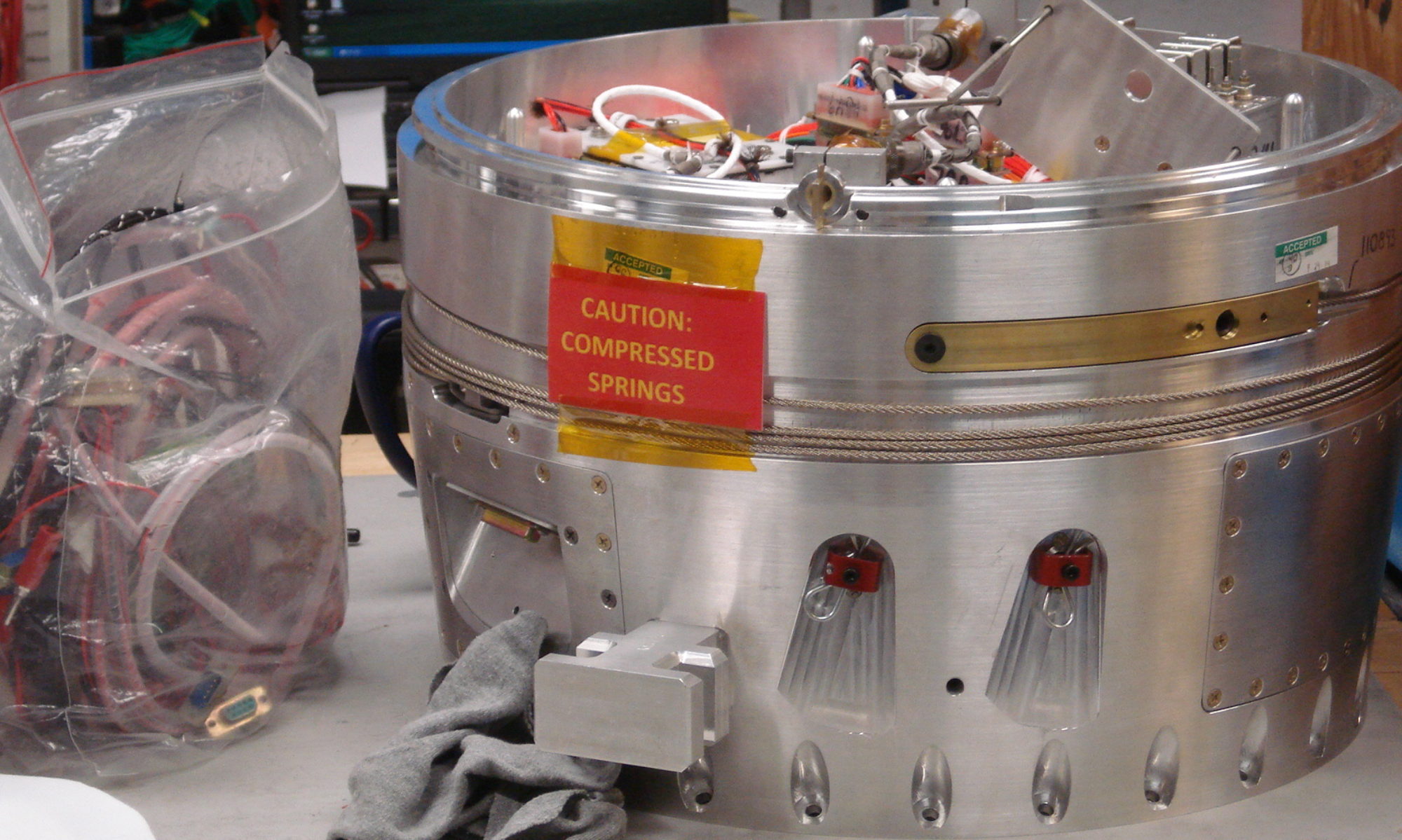
W4TI- Whiskey Four Tall Indians
Amateur Radio in Atlanta
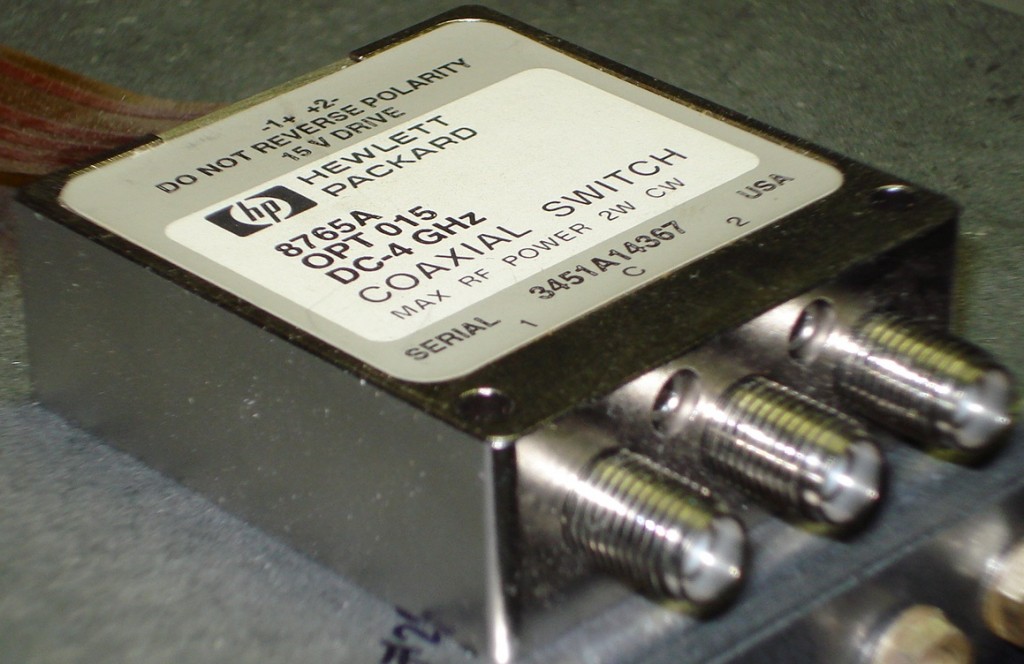
I think it is important to continually keep pressing forward, even when you don’t have much time or energy to do so. Sometimes, a hobby ceases priority for whatever reason- this causes the most adherent to call some wayward practitioner who succumbs to the rest of life as a sort of backslider, someone who doesn’t take things seriously. As if that was the only story that is true or worth telling.
When I wrote my paper for the SVHFS conference, I was hopeful that I would have feedback from those in attendance. So far, none is forthcoming. This is either because the paper was well written and satisfied a particular topic or because the paper itself was below the interest level of the average conference goer. This makes me wonder why I should expand on the paper for MUD, coming up later this year. Will I get feedback on that paper? Is it of interest to write introductory material for conferences which are clearly oriented towards those who are more advanced?
I can’t answer these questions, but I think they are worth examining if we are to successfully encourage more amateurs to become interested in microwave communication techniques. Ultimately the question to be answered is: to whom are we writing these documents and how can we better engage them?
I’m nearly done with the 902/3 W1GHZ project, even as it has taken over a year to complete. I merely need to plumb everything together, make sure the sequencer is working and that the antenna is tuned. First contact coming this summer!
Lot’s of irons in the fire! I’ve got many things going on which I will be reporting on shortly. In the meantime, let me give you, dear reader, a quick situational report.
*1) The ABPM from DEMI has been put together, but has been found somewhat lacking. I may have burned up a detector chip inside- this build and build notes are waiting for further testing before I chime in with my final thoughts. After all, if I burned something up, it is hardly DEMI’s fault, right?
*2) The 902 W1GHZ project is shortly going to bed. Now that I have a radio, interfacing is the last main issue. I have all the parts needed; once interfacing is done, I’ll be able to transfer it to a suitable container. Of course, if I had done this correctly, the container would have been the first part I had considered.
*3) I’m continuing work on the paper for the SVHFS conference publication. This will be ongoing until January. I also have an idea I am semi-working on for QST.
*4) By the grace of K4CSO, I came into a power meter cheaply and I hope to have a photo montage of it for the reader soon.
*5) I’m working on my Cookery pages to share recipes and, specifically, am currently working on delivering Grandma’s Vegetable Soup as a free recipe for all. Also, I have some thoughts about cornbread I would like to share. And Jello- I’m bringing back Jello.
*6) The 900MHz. amp is in as good a condition as I can make it- but no news on its stats yet. I had a couple of these at one time due to an eBay over bid and I got rid of all but one. Wish I hadn’t done that. That said, the old guard of uWaves don’t play on 900, as it is a band which either “shouldn’t be” or “worth having.” Which came first, the constructor or the contester?
*7) Recently taken advantage of a good deal and have some 10GHz material. When it gets here, I’ll have a better idea of its nature. At least, going to need an LO. Which reminds me- W7BAS never did come up with a 1296 transverter- but don’t take this as an indicator of the quality of the LO he produced, or any of his other projects- he is just very busy. Of the one LO I’ve received, it was really quite well done. But for now, scratch the 1296 xverter from W7BAS. It’s a no go (but maybe next year, if he gets some time to devote to the project!).
*8) All of this belittles the work I have been doing regarding t-shirts. I realize that may not mean much to you, but for those of us who buy them and use them over and over- and understand what the word piling means in regards to said- I’ve designed a t-shirt comparative. Because if I called it a t-shirt competition, well, where to go from there?
So, as you can see, lots of things going on.
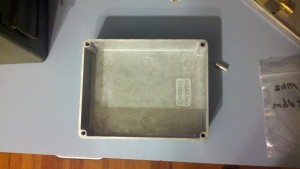
How are you going to do it? How are you going to build a 902/3 MHz. transverter so that you can activate a little used band and thereby increase your score in the VHF contest in which you are competing? Why would you do so? Since it isn’t a world wide allocation, there isn’t going to be any interest from abroad and very few US bound hams populate the band. More than that, how would you approach such a project if you had never done anything like it before? Where do you learn to be creative in your solution to your radio goal without having the requisite experience or training? Of course, if you had the experience, you’d have learned how to be creative in your answer about building a transverter and the question would be moot.
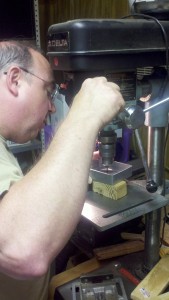
But it isn’t moot for me and building my transverter is still an ongoing process. I don’t have a drill press, for instance. If I did, what I could do with a couple minutes worth of measuring and using the right tool would save me weeks of time. I can’t journey up to see Charles but every so often and he can’t see me every day, either. So, you do the best with what you can regarding scheduling. Putting one of these together isn’t hard in terms of doing the soldering. But, this isn’t a case of having the right wire strippers and being able to make progress. When you use the wrong tool- impatience and a hand held drill in my case- you won’t get the clean results that you had previously (please note, the enlarged holes are the result of one wobbly bit which offset all other measurements. Use the right tool for the job!).
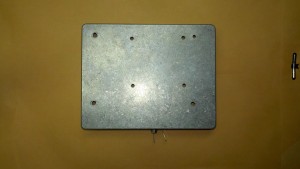
Even so, it isn’t the biggest mistake I’ve ever made. I decided on the Hammond box to be the enclosure for both the LO and transverter board. The LO doesn’t need to make any external connection through the wall of the box, so I put it in first (on the proper stand offs).
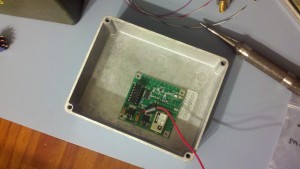 Of course, the LO had to be modified somewhat to interface with the W1GHZ transverter. The SMA connector was desoldered from the LO and new power lines and toroid were installed.
Of course, the LO had to be modified somewhat to interface with the W1GHZ transverter. The SMA connector was desoldered from the LO and new power lines and toroid were installed.
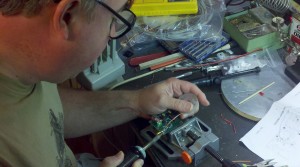 In place of the SMA connector from the LO, coax was installed which will directly interface (that is, be directly soldered) with/to the transverter board. Here this build gets down to brass tacks- the questions about how to engineer a 902/3 MHz. W1GHZ transverter now relies upon what sort of radio is going to be used, what sort of sequencer is best to run everything (I picked the TCK model from Down East Microwave, based on the coax relays I am going to be using- there are cheaper ways to go) and how best to interface all of these choices into one singular device. There is more to be said about this project, but can’t be without the proper pieces coming into place. Stay tuned!
In place of the SMA connector from the LO, coax was installed which will directly interface (that is, be directly soldered) with/to the transverter board. Here this build gets down to brass tacks- the questions about how to engineer a 902/3 MHz. W1GHZ transverter now relies upon what sort of radio is going to be used, what sort of sequencer is best to run everything (I picked the TCK model from Down East Microwave, based on the coax relays I am going to be using- there are cheaper ways to go) and how best to interface all of these choices into one singular device. There is more to be said about this project, but can’t be without the proper pieces coming into place. Stay tuned!
In other news, it may behoove the reader to use a bit of coax shield in the trench around the lid of the box. It helps to make contact between the lid and the body and will perhaps help you avoid producing or being receptive to RFI.
I was going to begin this post with the line, “Amplifiers are more trouble than they are worth,” but thought such hyperbole (which reminds me of my favorite example- “money is more trouble than it is worth.”) might be better left to poetry and in any case, in order to be heard, one has to have a little power.
The transverter itself has an output of about +15.25 dBm. That isn’t going to cut it- I wanted to have something in the full watts range to initially begin and will move up to the big Motorola amplifier after I get some air time with my baby system first (and eventually convert the big amp to work with my setup- more on that in the coming months/first of the new year). The problem becomes: how do you go from 32mW to, say, 5 watts, without too much trouble?
I asked the W1GHZ yahoo group what they were doing for driver amps, and one fellow mentioned the seller rfextra on ebay. He sells both a PA module and a development board (separate) which would be capable of doing what I was looking for. He sells the modules under the name “SHW5151.” Apparently, these modules have a Motorola pedigree- but of what kind and sort I cannot say as I am unable to locate a data sheet on this particular module. I’m certainly not picking on rfextra, as he supplies some links to schematics (and also supplies parts placement pictures) from a Motorola handheld in which this unit was used; you aren’t flying completely blind here. I’m happy with my purchase and left positive feedback. I would also point out that he sells a different module that also covers 33cm, but I have no knowledge or experience with it. I can tell you that I did not include the R3 resistor, as it wasn’t needed. And for the four inductors (L1-L4), I used two different sizes (0805 and 1206, as called for) of 22 uH.
As an aside, the W1GHZ Transverter group on Yahoo! is probably one of the best microwave groups around. There is very little noise and everyone is quite helpful. I scan the Mw list and the UK and VK microwave Yahoo! groups for information all the time- a very cursory review, believe me- how any one person keeps up with all the traffic must be someone who is either retired or a microwave junkie. That said, I really focus my attention on any posts from the W1GHZ transverter group whenever they show up in my email box- it’s usually that good. Especially when W9SZ speaks up. Zack is a treasure trove of information and he is always happy to share!
When I first began this part of the 902 W1GHZ transverter project, the module is not yet put down on the board, the board is populated with all the components and also has been fitted into its aluminum enclosure, as seen here:
When finished, with the very generous help of my Elmer K4CSO, the driver amp looks like this (minus cover):
The SMA mounts were drilled, tapped and installed. It has been plumbed for power, as noted by the wire coming off the regulator going to the external connector. The board, when finally set, used thermal grease on both the ground plane and underneath the module itself in order to mitigate as much heat as possible (actually, a great deal of the grease bled through the thru-way’s drilled into the board- care was taken to make sure the correct amount was smoothed over and used- one of the few cases of “less is more”). The bar set across the top of the module (the module underneath, I grant you, is difficult to see) is used to make sure that the module stays flush with the board- also incredibly important for heat transfer. Removing as much heat as possible is critical to the longevity of this module and I will eventually have to mount a fan to the underside- it runs that hot! Why go to all the trouble to build this if you aren’t going to take care of it?
Once the construction is taken care of how you see fit, which hopefully includes some manner of heat dispersion, one’s attention should turn toward the actual biasing of the module- the matters of voltage and current. According to rfextra, the module should be calibrated and reviewed, “Around 4-5V, monitor the current when(sic) increase the bias voltage: at low RF input like – 20dBm, stop when current is about 1.4-1.6A.” I didn’t have this information when we began to tune the amp- poor preparation on my part- and we simply ran out of time. However, a conservative approach got us to nearly the same place the instructions did, so all was not lost.
After placing some current on the device, it did not self-oscillate, which is a great sign. This means there is no RF escaping somewhere to induce the device to oscillate itself. We started driving the device around -20dBm and stopped around 0 dBm. We got about 4.4 watts out at this point and were hesitant to go further without proper biasing instructions (people are claiming 10 watts out of this module at 12 volts- I’m not interested in running it that hard). We did not pass one amp of current for biasing- which is not enough current as per the instructions, though we did hit 5.3 volts- which is beyond the upper end of the instructions I later received. So, we are lucky we didn’t destroy the component, but it also looks like we aren’t going to get too much more out of it, either. A little more tweaking will get closer to 5 watts, which is all I will need to drive the Motorola amp mentioned above. Of course, if I drive the big amp a little less, that’s not a worry, either. I’m not looking to wring out as many “deebees” as possible at the risk of destroying what I’ve already achieved. As it stands now, there probably isn’t much more tuning to be done and I am very happy with how the module turned out.
Now the question becomes one of how to attenuate the transverter output to feed the amp at around 0 dBm. If it isn’t one thing, its another!
I recall reading in the recent DUBUS magazine that something every VHF+ user could use was more power. Naturally, everyone could use more power! This fact escapes many people who run a barefoot (the all too common 100 watt) transceiver as their main rig. Many HF users believe 100 watts is the starting point; of course, there is the QRP bunch who do a lot of communicating with a great deal less power. Nevertheless, there is a large difference between what is QRP on HF and what counts for low power in the microwave domain. Additionally, there is also a large difference between what counts for QRO between HF and uWave spectrum, as well.
The transverter, as measured so far, puts out about 32mW. That’s just not very much- it could get lost in the coax! So, the plan is to build an amplifier that will take this output and turn it into something respectable (and not so hard to work for the other station!). Also, I would like this all to fit in the same box- that is, I want the transverter to be plug and play with at least +1 watt output with the xverter boards, switching, sequencing and at least one amp. After a couple of queries, I found something that I am hopeful will do the job.
A fellow on eBay is selling both a PA module and PCB board for a 5-10 watt (depending on how it is powered and biased) amplifier. Ultimately, I will be using this to drive another amplifier, but for now, I’m just trying to get my signal above the microwatt level! As I’ve not yet put mine together, I can’t say I recommend or that I dislike the seller. I should have the unit built in the next couple weeks to a month or so; if everything checks out, I’ll vouch for the guy and give the sellers name. The more curious and adventurous will have already looked up this information in the W1GHZ transverter group and will have found some driver amplifier solutions therein.
In other news, I feel like I am getting closer to a container for the xverter project. After a back and forth email missive with W7BAS, he mentioned that I should check out Context Engineering. (Also, while Bruce said he was not currently working on any 10 GHz project, he did say he “had some ideas” regarding a transverter. Stay tuned folks!) I like the boxes and different enclosures that CE has; that said, not sure what is going to be right for me. Charles, K4CSO, talks about the solutions to these difficulties as “3D thinking.” Wish I had more of it.
My 33cm W1GHZ transverter is assembled! However, it isn’t a fully functional transverter because I do not yet have a complete sequencing system in place. That said, the transverter and LO boards are assembled and plumbed. I am continually on the hunt for the right kind of enclosure to use for the entire bit of kit and hope to have something soon.
Recently, with the kind help of Charles, K4CSO, I was able to have the device tested and get its measurements checked. I don’t have the ability to check anything as I have no test equipment, and so I am very thankful for Charles to take time out of his day to lend a hand and expertise. I was surprised by the results- mainly that they worked at all! I don’t have a great deal of experience with surface mount soldering and often was concerned that I had cooked some part or other. Turns out everything works fine!
Considering the cost of these kits, one is getting a new band for not a lot of money. I secured the transverter boards and parts for $48. With connectors, switch, sequencer, power parts and eventually some sort of enclosure, I imagine the entire project will cost me $100. The same sort of thing (recognizing that there are significant differences between the two and that I’d rather have the DEMI if I could afford it) from DEMI would cost over $200 for the kit, and closer to $300. The next comparable 902/3 transverter kit is from W7BAS and is currently $199 plus $6 for shipping. So, like I said, you are getting on a new band for not a lot of money- but how well does it work?
I put the LO board together first. I decided that the best way to approach this would be to solder all the capacitors and resistors in place and then move on to the more delicate MMICs, crystal oscillator and voltage regulator. This worked very well; if I had it to do again (and I will for my 1296 board), the only difference would be that I would solder the PCB to SMA (coax connector) first. It appeared to take a lot of heat to get the connector warmed up and as a result it transfered a lot of heat to the board. If you put this connector on first, you won’t run the risk of cooking the nearby MMIC. And speaking of MMICs, I used the MAR-6 and MAR-1 from Minicircuits as was listed in the parts sheet by Paul Wade.
After applying some power (the +12 → +8 volt power plant was built using an LM7808 bolted to the ground plane), the current limiter said that the board drew 82 milliamperes. Not a lot of current! The LO output was +6.68 dBm, right where it should be for the +7dBm mixer on the transverter board (which had to be jumpered to reach the LO; I used a small piece of brass stock you can get from most hardware stores to jump the trace). What was odd, however, was the frequency itself was not as close as I would have liked- the LO’s output is 755.985 MHz, off by 15 kHz from the goal of 756 MHz. Doing a mild heat test of the crystal revealed that with an increase in temperature (unmeasured; used a heat gun), the crystal drifted another 10 kHz and landed at 755.975 MHz. A better crystal oscillator would be closer to the desired frequency, as the Cardinal one that was supplied had a stability rating of +/- 100 ppm- they make them down to +/- 5 ppm in this particular form factor. Eventually, even the hobbyist will have some sort of synthesizer to do the heavy frequency (timing) lifting that was once the domain of the crystal oscillator (you should really check out Andy’s, G4JNT, website for some synthesizer projects).
The transverter board itself was fairly easy to put together. I would warn other folks to mind where you are putting the power supply capacitors for the T/R circuits, as you will want to drape some off the edge, so to speak, and make sure that the wire you want to use is in the right place and soldered down before you put in all the caps. Alternatively, you may want to place them on the bottom of the board. Here again, it is better to think of the major parts (plumbing and power) that have to fit somewhere first and then worry about where the little stuff is going to go.
I was pleased that the transverter put out +15.25 dBm (or, approximately 32 mW). The TX side of the circuit took 187 milliamperes and the RX side of the circuit 120 milliamperes. The 1 dB compression point (or more formally, P1dB) was at -2 dBm. So, at least for my transverter, I need to attenuate my radio to -2 dBm output drive in order to avoid saturating the circuit. Here, I used the following MMICs: A1=SGA3586Z, A2=MAR-6SM and A3=ERA-5SM.
The weak spot in this transverter board design, other than no consideration for built in power on any board that uses +12V input like most do, are the filters. PCB filters aren’t nearly as tight as something one might otherwise procure from Mouser, but certainly will be at a higher cost than using the hairpin PCB filter. Here again, we are confronted with price versus performance. For what I am trying to do, I’ll be able to get by- but for those who like to hack around and make something more than what is given, I believe there are 900 MHz bandpass filters to be had that could tighten up the transverter without doing too much looking.
At the end of things, I’m pleased with the boards. If you want to try to add a band cheaply, but not expect perfection from your price, I think you have found the right kind of kit. I can only think of two improvements I would like to make: (1) at some point I’m definitely going to insulate the crystal with some Styrofoam and (2) may even build some shielding over the PCB hairpin filters. With these two ends tied up, I should have a fairly decent way by which to get on 33cm!
A very nicely documented build of a 1.2 kit by 9A4QV.
Very nice and clean- check out the enclosure!
Hello Everyone.
As of today everything is out in the mail and on there way except the two Canadian orders. Those I will handle tomorrow morning right when the Post Office opens up as I need to hand those directly to a clerk to process.
My apologize to everyone for this being so drawn out and taking so long. Like I mentioned in the last update, I had not planned properly when I did this. I did it more as a spur of the moment thing and not thought it out rationally before hand.
For those that have a @amsat.org email address and tried to contact me, my ISP is blocking all amsat.org addresses currently because of supposed spam messages using the amsat.org alias…:( That even includes me receiving my weekly sending of the Weekly Satellite Report…:(
Merry Xmas to everyone!!
James W8ISS
Another note from Mr. French:
I didn’t realize that it has been almost a month since I posted the last update. Sorry about that. I wasn’t keeping track of the time and all.
I have everything finally packaged up and will start shipping out orders on Saturday starting with the first orders and going down my list based on when I received them.
I found that I came up short by a few boards and wanted to double check everything before I start to ship anything out including the parts for each kit. That is done finally. As for the boards that I am short on, I have placed another order with Paul to get those to place in the last orders. I will contact those persons directly to see what they would like to handle this mistake of mine. If you do not receive an email from me about this, then please don’t worry.
Sorry about not getting things out as I had promised. I did not factor in a lot of things that I should have that are different from when I did last years group purchase. Last year I had plenty of time to devote to this because I was off work (injury). I thought I could do it again in the same time frame as I did before.
These will be here soon!